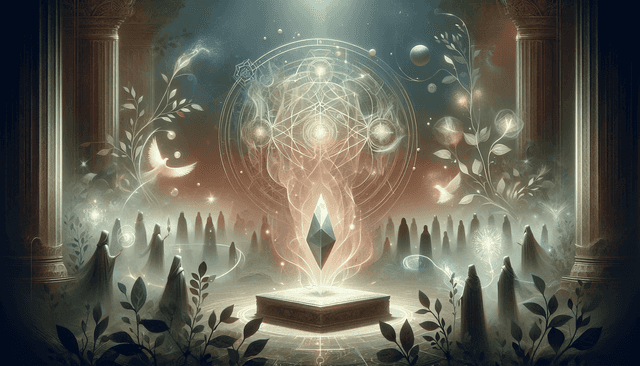Table of Contents
So, you’re diving into the epic world of fantasy writing but feeling a bit lost on how to outline your novel? Don’t worry! Many aspiring writers stumble at this stage, overwhelmed by the vast possibilities that come with building magical realms and unforgettable characters. It’s totally understandable; where do you even begin?
Well, stick around! If you keep reading, I’ll take you through a simple step-by-step process that’ll help you outline your fantasy novel like a pro. You’ll see that mapping out your story can actually be both fun and rewarding, allowing your imagination to soar without losing your way.
We’ll cover everything from brainstorming ideas and creating intricate worlds to developing unique magic systems and structuring your plot. By the end, you’ll have a solid outline ready to bring your fantasy adventure to life!
Key Takeaways
Stefan’s Audio Takeaway
- Brainstorm and organize your fantasy ideas, focusing on a central conflict or theme.
- Create a detailed fantasy world with geography, cultures, and a backstory.
- Develop well-rounded characters, including their motivations and personal arcs.
- Design a unique magic system with clear rules and impact on society.
- Structure your plot using a three-act format for better pacing and engagement.
- Organize your outline into acts and scenes, ensuring clarity and flow.
- Detail each chapter’s purpose, characters, and themes for cohesive storytelling.
- Review and revise your outline for consistency, plot holes, and character development.

Step 1: Outline Your Fantasy Novel Ideas
The first step to writing a fantasy novel is brainstorming and organizing your ideas. Start by jotting down various concepts, themes, or magical elements that excite you. If you find yourself stuck, try using writing prompts to spark your creativity.
As you outline your ideas, think about the central conflict or theme that will drive your story. Is it a quest for a mystical artifact? A battle between good and evil? Keeping your main idea in focus will provide direction as you flesh out your plot.
Don’t hesitate to play with different ideas. Mixing genres can lead to fascinating stories, like combining urban fantasy with elements of mystery. Embrace your unique perspective—it’s your secret weapon!
Step 2: Create Your Fantasy World
World-building is crucial in fantasy writing; it’s like creating a character that breathes life into your story. Start by determining the rules of your universe. Will it have magic? If so, what are its limitations?
Next, sketch out the geography of your world. Think about the landscapes, climates, and cultures that exist within it. You might want to craft a map to visualize your world better. Tools like interactive ebook software can also help you design your location-based narratives.
Creating a history for your world adds depth. Consider how its past events shape the current conflict or characters. Ask yourself: What myths or legends do the inhabitants believe in? These elements enhance the realism of your world.
Step 3: Develop Your Characters
Your characters are the heart of your story. Start by defining their strengths, weaknesses, and motivations. Try creating a character sheet that includes their background information and role in the plot.
Think beyond your protagonist. Secondary characters can offer rich subplots and add complexity. For instance, a loyal sidekick could have hidden strengths that emerge at a critical moment.
Moreover, don’t forget to give your characters personal arcs. Whether they gain confidence or learn a lesson, showing their growth makes readers more invested. Observing other popular fantasy series can provide inspiration on how characters evolve.

Step 4: Design Your Magic System
Creating a unique magic system can set your fantasy story apart from the rest.
Start by defining the source of your magic. Is it derived from nature, ancient artifacts, or perhaps the bloodline of specific families?
Next, consider the rules and limitations. What can magic do? Are there costs to using it, like draining life energy or requiring rare materials?
Incorporate different types of magic users. Perhaps some are scholars who study magic, while others wield it instinctively.
Examples of solid magic systems can be found in series like “Mistborn” by Brandon Sanderson, where each type has distinct limits and costs.
Think about how your magic affects society and culture. Does it inspire fear or reverence? This can add much depth to your world.
Step 5: Structure Your Plot
Structure is the backbone of your story, guiding readers on an engaging journey.
A common method is the three-act structure, which divides your plot into a setup, confrontation, and resolution.
In the first act, lay down the groundwork—introduce your characters and the central conflict. This should take about 25% of your total word count.
The second act is where things get intense, usually comprising about 50% of the story. Here, complicate the conflict and put your characters in challenging situations.
The third act wraps up the story, resolving the conflict and giving readers closure.
Remember, outlining major plot points can help you stay organized. You can use free tools to visualize your plot structure better.
Step 6: Organize Your Outline
Once you’ve structured your story, it’s time to organize your outline effectively.
Break your outline into sections based on the three acts, then detail each major scene within these acts.
Group related scenes together for clarity. This will help you see how the story flows and where adjustments are needed.
Consider using bullet points or numbered lists to keep things clear and straightforward.
Don’t forget to leave room for character arcs and subplots in your outline; they add richness to your main story.
Step 7: Detail Each Chapter
Going chapter by chapter can help you focus on details while keeping the larger narrative in mind.
Start by summarizing what each chapter will accomplish. This helps ensure each one pushes the story forward.
Think about which characters will appear in each chapter and what their motivations are.
Include thematic elements to make sure each chapter contributes to the overall message or feeling of the story.
Remember, your chapters can vary in length, but keeping an average of around 1,500 words per scene can create a nice rhythm.
Step 8: Review and Revise Your Outline
After detailing each chapter, it’s crucial to review your outline for consistency and flow.
Take a step back. Read through your outline to spot any plot holes or character inconsistencies.
Consider sharing your outline with a friend or fellow writer for a fresh perspective. They might catch things you missed.
Don’t hesitate to make major changes. Sometimes the best ideas come from reworking sections of your outline.
Above all, ensure your outline aligns with the overall length norms for your genre. This consistency can keep readers engaged and ensure your story fits the expectations of its audience. For instance, epic fantasy often ranges from 114,000 to 310,000 words, while YA fantasy typically falls between 77,000 and 156,000 words.
FAQs
Begin by brainstorming concepts such as themes, settings, and conflicts. Make a list of unique character ideas and magical elements. Use these notes to create a preliminary outline that captures your novel’s main ideas and vision.
Think about the geography, culture, politics, and history of your world. Consider how magic influences day-to-day life and societal structures. Ensure consistency in rules and details to create a believable and immersive setting.
Focus on creating multi-dimensional characters with distinct motivations, strengths, and flaws. Give them unique backstories and relationships that impact their development throughout the plot. Aim for relatable traits to enhance reader connection.
Establish clear rules governing how magic works, its limitations, and consequences. Consider its source, accessibility, and cultural perception. Consistency in your magic system will help maintain immersion and support the plot’s progression.



